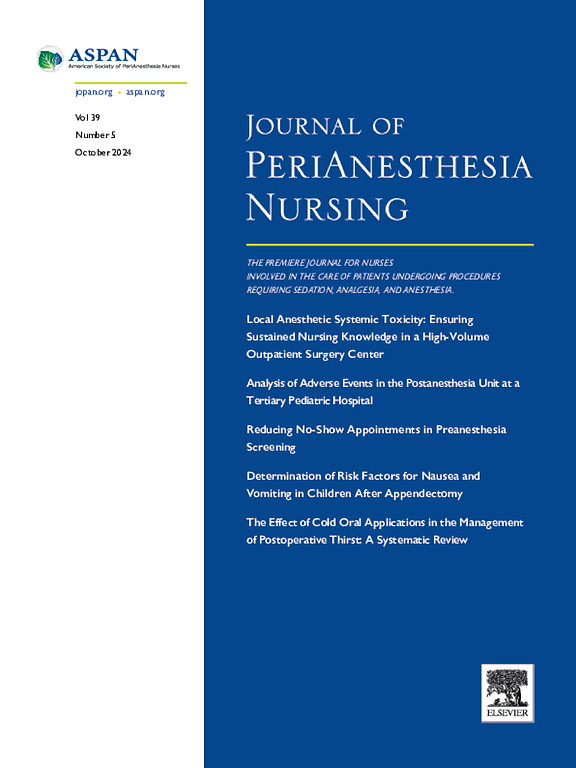The Use of Prophylactic Ketamine to Mitigate Postoperative Depressive Symptoms: A Systematic Review
IF 1.6
4区 医学
Q2 NURSING
引用次数: 0
Abstract
Purpose
Depression is predicted to be the leading burden of disease worldwide by 2030 with a prevalence of 10% to 60% in the surgical population. Depressive symptoms in the perioperative population are associated with a myriad of grave complications, including higher morbidity and mortality. This systematic review aims to determine whether a single dose of intravenous ketamine can be used prophylactically as a routine resilience-enhancing agent in all high-risk adult patients undergoing surgery to mitigate depressive symptoms postoperatively by appraising evidence of existing literature.
Design
An evidence-based systematic review.
Methods
The databases PubMed, CINAHL, and Scopus were searched, adhering to the Preferred Reporting Items for Systematic Reviews and Meta-analyses guidelines. Search and Medical Subject Headings (MeSH) terms used: “ketamine,” “surgical procedures,” “surgical,” “surgery,” “depression,” and “depressive disorder.”
Findings
In 9 randomized controlled trials (RCTs), bolus ketamine doses of 0.1 mg/kg to 1 mg/kg were administered intraoperatively or in the postanesthesia care unit. The primary outcome was the subjective feelings of depression as evaluated by different validated depression screening tools and seven RCTs observed statistically significant findings between the control and intervention (ketamine) groups with postoperative depression scores. Two RCTs did not find a significant change in depression scores.
Conclusions
Research on the use of prophylactic ketamine as an antidepressant in the perioperative population offers insight into changing routine practices and can shape how mental health is viewed in hospitals. Further research is warranted on the safety profile of ketamine, and risk stratification with careful consideration of baseline depressive symptoms, timing, and its use across a wider variety of surgical subspecialties.
使用预防性氯胺酮缓解术后抑郁症状:系统回顾
目的:据预测,到 2030 年,抑郁症将成为全球主要的疾病负担,在手术人群中的发病率为 10%至 60%。围手术期人群中的抑郁症状与多种严重并发症有关,包括发病率和死亡率较高。本系统性综述旨在通过对现有文献证据的评估,确定是否可将单剂量静脉注射氯胺酮作为一种常规抗抑郁药,预防性地用于所有接受手术的高风险成人患者,以减轻术后抑郁症状:设计:基于证据的系统综述:方法:根据《系统综述和元分析首选报告项目》指南,对PubMed、CINAHL和Scopus数据库进行检索。使用的检索词和医学主题词(MeSH)包括"氯胺酮"、"外科手术"、"外科"、"手术"、"抑郁症 "和 "抑郁障碍":在9项随机对照试验(RCT)中,术中或麻醉后护理病房中使用的氯胺酮剂量为0.1毫克/千克至1毫克/千克。七项研究发现,对照组和干预组(氯胺酮)的术后抑郁评分在统计学上有显著差异。有两项研究发现抑郁评分没有明显变化:关于在围手术期人群中使用氯胺酮作为抗抑郁药的研究为改变常规做法提供了启示,并能影响医院对心理健康的看法。关于氯胺酮的安全性、风险分层、基线抑郁症状、使用时机以及在更广泛的外科亚专科中使用氯胺酮的问题还需要进一步研究。
本文章由计算机程序翻译,如有差异,请以英文原文为准。
求助全文
约1分钟内获得全文
求助全文
来源期刊

Journal of Perianesthesia Nursing
NURSING-
CiteScore
2.20
自引率
17.60%
发文量
279
审稿时长
90 days
期刊介绍:
The Journal of PeriAnesthesia Nursing provides original, peer-reviewed research for a primary audience that includes nurses in perianesthesia settings, including ambulatory surgery, preadmission testing, postanesthesia care (Phases I and II), extended observation, and pain management. The Journal provides a forum for sharing professional knowledge and experience relating to management, ethics, legislation, research, and other aspects of perianesthesia nursing.
 求助内容:
求助内容: 应助结果提醒方式:
应助结果提醒方式:


